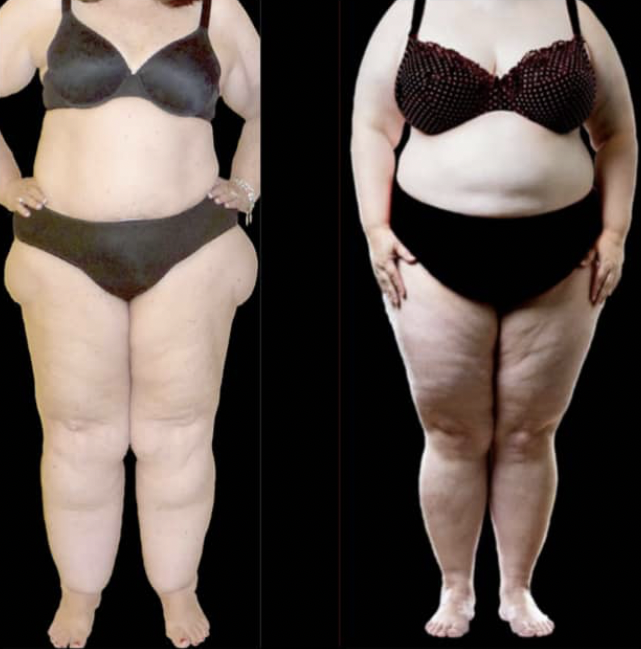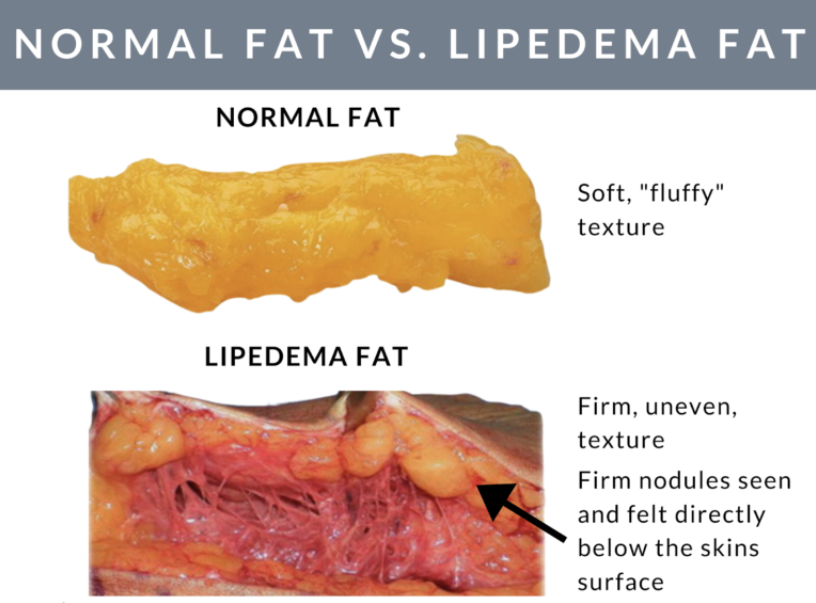Medically reviewed by Dr. Anuj Kr Purbey.
Have you ever been told to just ‘lose weight’ despite your lower body staying the same size no matter how hard you try?
The truth is, Lipedema fat is not the same as normal fat. It looks different, feels different and Lipedema responds very differently to diet and exercise. Let’s break down the key differences so you can better understand your body and why Lipedema is so often misunderstood.
What Is Normal Fat?
‘Normal’ fat, also known as adipose tissue, is the body’s way of storing energy. It tends to accumulate or reduce based on:
- Calorie intake vs calories burned
- Hormones (like insulin and cortisol)
- Activity levels
- Genetics and lifestyle
It’s more evenly distributed throughout the body and can be lost with weight loss efforts.
What Is Lipedema Fat?
Lipedema is a chronic, progressive fat disorder. It typically affects the:
- Hips
- Thighs
- Buttocks
- Calves
- Sometimes arms – especially Lipedema in the upper arms
Lipedema is resistant to diet and exercise and often grows disproportionately compared to the upper body.
Key Differences Between Lipedema Fat vs Normal Fat
|
Feature |
Normal Fat |
Lipedema Fat |
|
Responds to diet/exercise |
Yes |
No (or very little) |
|
Symmetry |
Even body distribution |
Typically symmetrical in legs/arms only |
|
Texture |
Smooth and soft |
Nodular, lumpy, often painful to touch |
|
Pain |
Usually painless |
Tender, sore, or bruises easily |
|
Swelling |
Rare |
Common – especially later in the day |
|
Location |
Varies (abdomen, arms, face etc) |
Mainly the lower body, sparing the hands and feet |
What Does Lipedema Fat Feel Like?
Many women describe Lipedema fat as:
- “Lumpy like peas under the skin or rice pudding”
- “Heavier than normal fat”
- “Tight and painful”
- “Susceptible to unexplained Lipedema bruising”
Unlike regular fat, Lipedema fat often causes soreness or aching, especially when touched or after long periods of standing.
Why Lipedema Fat Doesn’t Budge
You can eat well. You can exercise. You can do everything ‘right’. But Lipedema fat doesn’t respond in the same way normal fat does.
That’s because this type of fat is:
- Hormone-related (often worsens at puberty, pregnancy, or menopause)
- Structurally different – more fibrotic and inflamed
- Often associated with lymphatic impairment
This is why so many women with Lipedema report losing weight from their upper body, while their legs stay pretty much the same.
How to Tell the Difference
It’s not always easy, especially if you’ve been told it’s just weight gain or cellulite. But signs that your fat may be Lipedema-related include:
- A clear disproportion between upper and lower body
- Fat that doesn’t respond to calorie deficits
- Lipedema related pain or bruised fat deposits
- ‘Cuffing’ at the ankles or wrists (legs look swollen but feet/hands are spared)
- Worsening Lipedema symptoms during hormonal changes
Can you have Lipedema Fat and Normal Fat?
Yes. Many women have both normal fat and Lipedema fat – which can make weight loss frustrating and confusing.
It’s entirely possible to have:
- Obesity and Lipedema
- Normal weight and Lipedema
- A healthy BMI but still carry Lipedema fat
This is why BMI alone doesn’t tell the whole story, it’s an unreliable measurement – especially for women with Lipedema.
What to Do If You Suspect Lipedema
If you suspect you have Lipedema, the Lipedema pinch test is a good place to start. But ultimately, if you’re nodding along to these symptoms, seeking a proper Lipedema diagnosis is vital.
Check out our Lipedema Specialist Directory for professionals who understand Lipedema and can help you get answers. Bring photos, symptom tracking and info like the chart above to your appointment. And if your GP dismisses you, keep going – you deserve care that recognises what you’re dealing with.
Lipedema Fat vs Normal Fat Isn’t Just a Cosmetic Issue
Lipedema fat isn’t caused by laziness, overeating, or lack of willpower. It’s a medical condition that requires understanding and can be managed with conservative measures for Lipedema.
By knowing the difference between Lipedema fat and normal fat, you’re better equipped to:
- Advocate for a diagnosis
- Understand why weight loss efforts alone aren’t working
- Access the right care and support
- Be kinder to yourself when your body doesn’t behave the way others expect it to
Remember my inbox is always open, I’ve been managing my stage 2 Lipedema for almost three years and have established a routine that works for me. There’s no need to struggle alone, send me an email on so****@***********me.com.
Disclaimer: This article has been medically reviewed by Dr. Anuj Kr Purbey to ensure accuracy. However, it is provided for informational purposes only and should not replace in-person medical advice. Always consult your doctor or a qualified specialist for diagnosis and treatment.



Hi Sophie,
After a referral from my GP followed by a wait of over 12 months for an appointment at a well-regarded centre specialising in Lymphoedema, I was finally diagnosed with Lipoedema. Of course, after extensive research, I am aware there is no “cure”, only guidelines for its management.
I have no problem following the anti-inflammatory diet and exercise recommendations BUT finding suitable compression garments for thigh and knee support is proving to be difficult.
TLC Sport Co.uk. were recommended by the hospital physiotherapist and that company are, to say the least, AMAZING. They’ve sent me several difference ‘shapes’ and sizes, with no postage costs even when returning them….. but, of course, they are not catering specifically for the Lipoedema ‘shape’.
I have managed to buy one pair of leggings from them which feel extremely comfortable – but it’s from a ‘high-waisted’ range. They’ll be my go-to leggings once winter returns but the high waist is high, right up to my bra line, which is far too warm for summer wear. Their ‘normal’ waist fitting leggings were actually too loose on my waist and curled over. I am a typical Lipoedema shape; bulky from the hips down.
So, to get to my question, can you recommend any other reputable company where I can continue my search for leggings which fit?
I look forward to hearing from you.
With many thanks for reading.